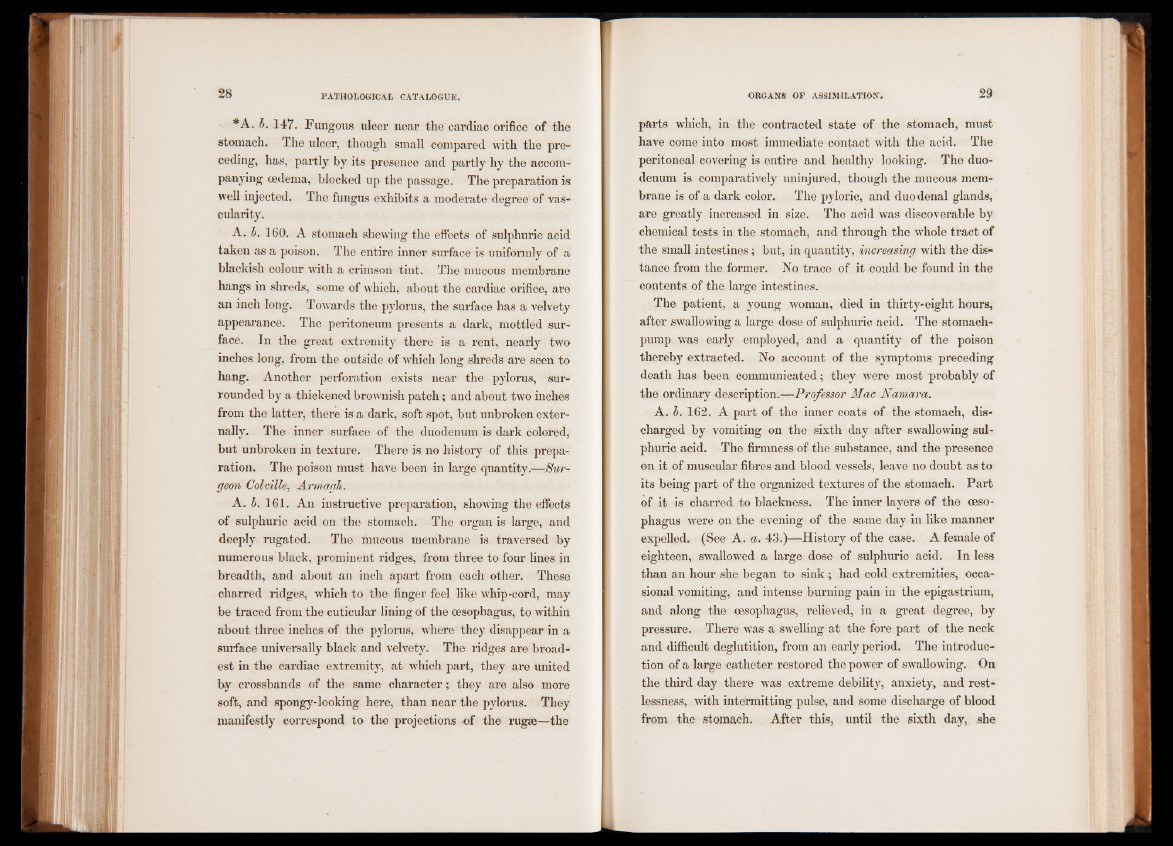
*A. b. 147. F ungous ulcer near the cardiac orifice of the
stomach. The ulcer, though small compared with the preceding,
has, partly by its presence and partly hy the accompanying
oedema, blocked up the passage. The preparation is
well injected. The fungus exhibits a moderate degree of vascularity.
A. b. 160. A stomach shewing the effects of sulphuric acid
taken as a poison. The entire inner surface is uniformly of a
blackish colour with a crimson tint. The mucous membrane
hangs in shreds, some of which, about the cardiac orifice, are
an inch long. Towards the pylorus, the surface has a velvety
appearance. The peritoneum presents a dark, mottled surface.
In the great extremity there is a rent, nearly two
inches long, from the outside of which long shreds are seen to
hang. Another perforation exists near the pylorus, surrounded
by a thickened brownish patch; and about two inches
from the latter, there is a dark, soft spot, but unbroken externally.
The inner surface of the duodenum is dark colored,
but unbroken in texture. There is no history of this preparation.
The poison must have been in large quantity.—Surgeon
Colville, Armagh.
A. b. 161. An instructive preparation, showing the effects
of sulphuric acid on the stomach. The organ is large, and
deeply rugated. The mucous membrane is traversed by
numerous black, prominent ridges, from three to four lines in
breadth, and about an inch apart from each other. These
charred ridges, which to the finger feel like whip-cord, may
be traced from the cuticular lining of the oesophagus, to within
about three inches of the pylorus, where they disappear in a
surface universally black and velvety. The ridges are broadest
in the cardiac extremity, at which part, they are united
by crossbands of the same character; they are also more
soft, and spongy-looking here, than near the pylorus. They
manifestly correspond to the projections of the rugse—the
parts which, in the contracted state of the stomach, must
have come into most immediate contact with the acid. The
peritoneal covering is entire and healthy looking. The duodenum
is comparatively uninjured, though the mucous membrane
is of a dark color. The pyloric, and duodenal glands,
are greatly increased in size. The acid was discoverable by
chemical tests in the stomach, and through the whole tract of
the small intestines; but, in quantity, increasing with the distance
from the former. No trace of it could be found in the
contents of the large intestines.
The patient, a young woman, died in thirty-eight hours,
after swallowing a large dose of sulphuric acid. The stomach-
pump was early employed, and a quantity of the poison
thereby extracted. No account of the symptoms preceding
death has been communicated; they were most probably of
the ordinary description.—Professor Mac Namara.
A. b. 162. A part of the inner coats of the stomach, discharged
by vomiting on the sixth day after swallowing sulphuric
acid. The firmness of the substance, and the presence
on it of muscular fibres and blood vessels, leave no doubt as to
its being part of the organized textures of the stomach. Part
of it is charred to blackness. The inner layers of the oesophagus
were on the evening of the same day in like manner
expelled. (See A. a, 43.)—History of the case. A female of
eighteen, swallowed a large dose of sulphuric acid. In less
than an hour she began to sink ; had cold extremities, occasional
vomiting, and intense burning pain in the epigastrium,
and along the oesophagus, relieved, in a great degree, by
pressure. There was a swelling at the fore part of the neck
and difficult deglutition, from an early period. The introduction
of a large catheter restored the power of swallowing. On
the third day there was extreme debility, anxiety, and restlessness,
with intermitting pulse, and some discharge of blood
from the stomach. After this, until the sixth day, she